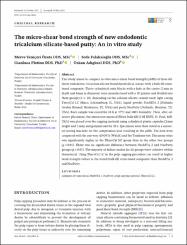| dc.contributor.author | Yeniçeri Özata, Merve | |
| dc.contributor.author | Falakaloğlu, Seda | |
| dc.contributor.author | Plotino, Gianluca | |
| dc.contributor.author | Adıgüzel, Özkan | |
| dc.date.accessioned | 2022-06-13T09:23:45Z | |
| dc.date.available | 2022-06-13T09:23:45Z | |
| dc.date.issued | 04.06.2022 | en_US |
| dc.identifier.citation | Özata, M. Y., Falakaloğlu, S., Plotino, G., & Adıgüzel, Ö. (2022). The micro‐shear bond strength of new endodontic tricalcium silicate‐based putty: An in vitro study. Australian Endodontic Journal. | en_US |
| dc.identifier.issn | 1329-1947 | |
| dc.identifier.uri | https://doi.org/10.1111/aej.12631 | |
| dc.identifier.uri | https://hdl.handle.net/20.500.12933/1151 | |
| dc.description.abstract | This study aimed to compare in vitro micro-shear bond strength (μSBS) of three different endodontic tricalcium silicate-based materials in contact with a bulk-fill resin-based composite. Thirty cylindrical resin blocks with a hole in the centre (2 mm in depth and 4 mm in diameter) were manufactured with a 3D printer and divided into three groups (n = 10), depending on the calcium silicate cement used: light curing TheraCal LC (Bisco, Schaumburg, IL, USA), liquid–powder NeoMTA 2 (NuSmile Avalon Biomed, Bradenton, FL, USA) and putty NeoPutty (NuSmile, Houston, TX, USA). Each sample was stored for 24 h at 37°C and 100% humidity. Then, after adhesive placement, the restorative material Filtek bulk-fill (3 M ESPE, St. Paul, MN, USA) was placed over the capping material using cylindrical plastic capsules (2 mm height and 2 mm) and polymerised for 20 s. Specimens were then tested in a universal testing machine for the compression load resulting in the μSBS. The data were compared with the one-way ANOVA (Welch) and the Tamhane test. The mean value was significantly higher in the TheraCal LC group than in the other two groups (p < 0.05). There was no significant difference between NeoMTA 2 and NeoPutty groups (p > 0.05). The majority of failure modes for all groups were cohesive within biomaterial. Using TheraCal LC in the pulp capping procedure can result in higher bond strength values to the tested bulk-fill resin-based composite than NeoMTA 2 and NeoPutty. | en_US |
| dc.language.iso | eng | en_US |
| dc.publisher | John Wiley and Sons Inc | en_US |
| dc.relation.isversionof | 10.1111/aej.12631 | en_US |
| dc.rights | info:eu-repo/semantics/embargoedAccess | en_US |
| dc.subject | Adhesion of biomaterial | en_US |
| dc.subject | NeoMTA 2 | en_US |
| dc.subject | NeoPutty | en_US |
| dc.subject | Pulp capping material | en_US |
| dc.subject | TheraCal LC | en_US |
| dc.title | The micro-shear bond strength of new endodontic tricalcium silicate-based putty: An in vitro study | en_US |
| dc.type | article | en_US |
| dc.authorid | 0000-0001-5230-969X | en_US |
| dc.department | AFSÜ, Diş Hekimliği Fakültesi, Klinik Bilimler Bölümü | en_US |
| dc.contributor.institutionauthor | Falakaloğlu, Seda | |
| dc.identifier.startpage | 1 | en_US |
| dc.identifier.endpage | 6 | en_US |
| dc.relation.journal | Australian Endodontic Journal | en_US |
| dc.relation.publicationcategory | Makale - Uluslararası Hakemli Dergi - Kurum Öğretim Elemanı | en_US |
















